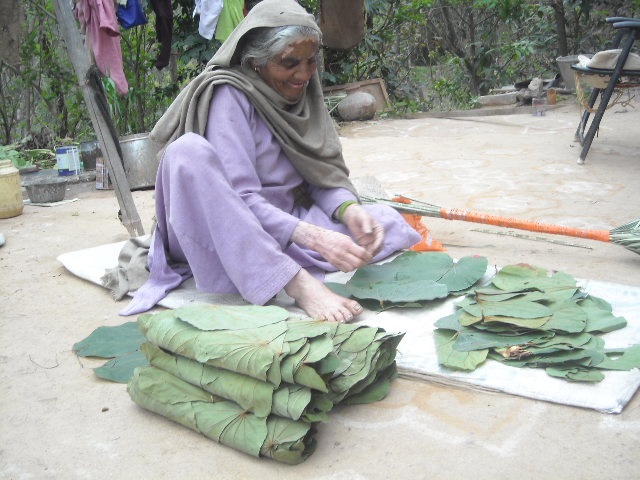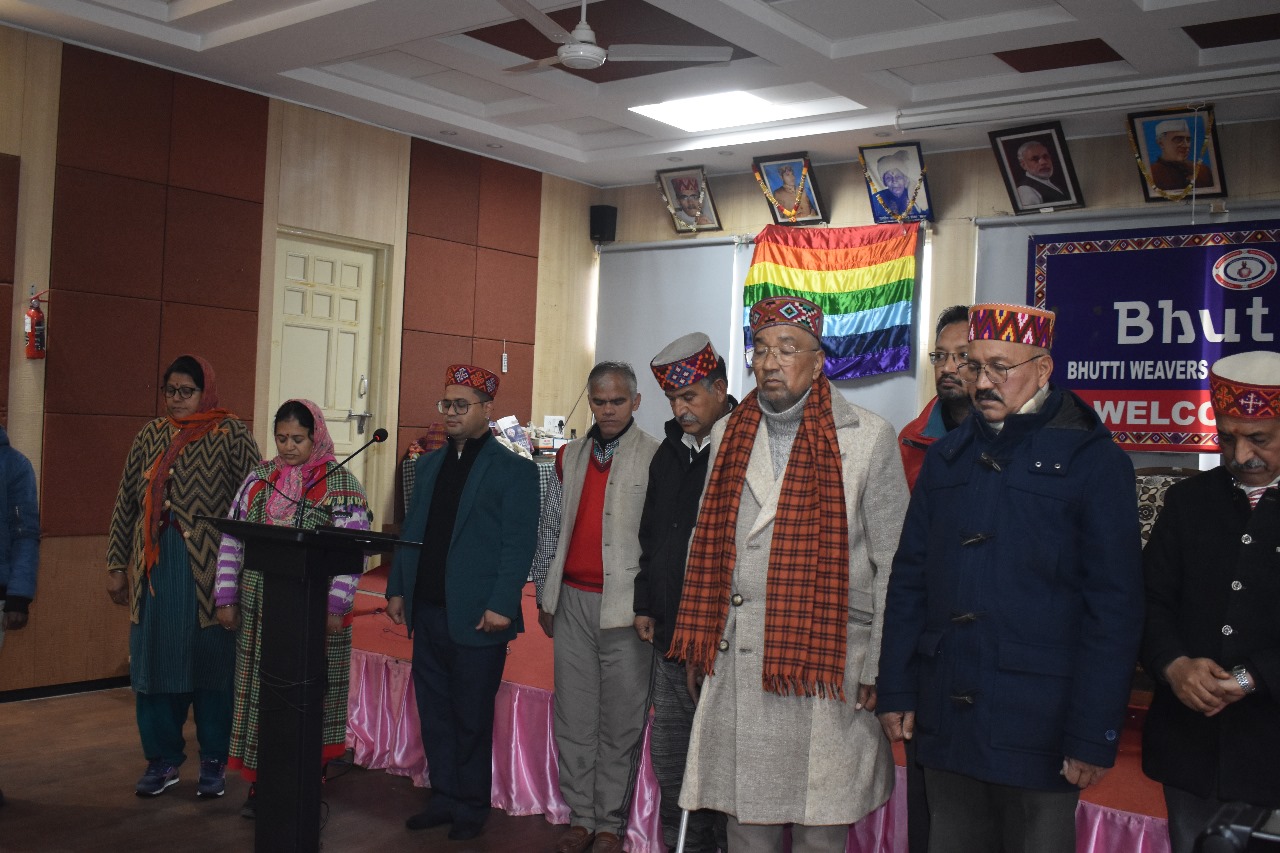Embracing Diversity of Leaf Plates: A Return to Nature for Health and Sustainability.

Shimla:
In an era dominated by plastic and synthetic materials, the resurgence of leaf plates presents a compelling narrative of sustainability, health, and cultural heritage. These natural alternatives, crafted from the leaves of various plants, are not only a nod to tradition but also a beacon of hope for a planet grappling with pollution and waste management issues.
The Diverse World of Leaf Plates.
Leaf plates have been an integral part of numerous cultures worldwide. In India, for instance, plates made from the leaves of the maloo creeper, sal tree, banana, and banyan have been used for centuries. Additionally, there is a tradition of eating on leaf plates made from palash, gogan, and Roxburgh fig in some regions due to their easy availability and health benefits. Each type of leaf brings its unique properties and benefits:
Maloo Creeper (Tour) Leaves: Widely used in North India, Maloo leaves are traditionally utilized in various medicinal practices. Known for their antibacterial properties, they help maintain hygiene when used as plates. The natural compounds present in these leaves can enhance the flavor of the food, offering a unique dining experience that has been appreciated for generations. Plates and bowls made of these leaves are heavily utilized in almost social or religious gathering until dominance of cheap plastic plates and bowls. However, in view of their adverse effect on environment plastic bowls has been banned in some sacred waterbodies.
Banana Leaves: Not very common in North India, however frequently used in South India and Southeast Asia. Banana leaves are large, flexible, and impart a subtle flavor to the food served on them. They are also rich in polyphenols, which have antioxidant properties.
Banyan Leaves: Though less common, banyan leaves are used in some regions for their antibacterial properties, making them a hygienic choice.
Sal Leaves: Known for their durability, sal leaves are stitched together to form sturdy plates and bowls. They are resistant to high temperatures, making them ideal for serving hot food.
Palash Leaves: Commonly known as Flame of the Forest, palash leaves are large and sturdy, making them ideal for crafting plates. The leaves have medicinal properties and are used in Ayurvedic practices for their anti-inflammatory and antioxidant benefits.
Gogan Leaves: Known for their large, sturdy leaves, Gogan offers a natural alternative to plastic and other non-biodegradable materials. Though less common, they align well with the global push towards sustainability.
Roxburgh fig Leaves: Preferred for small social gatherings, Roxburgh fig leaves are broad and robust, suitable for holding large portions of food. Their natural antimicrobial properties help reduce the risk of foodborne illnesses. But their use has declined significantly with dominance of plastic plates.
Indian trumpet tree: Leaf plates and bowls made from Indian trumpet tree are not only eco-friendly but also offer several health benefits. Its anti-inflammatory, antimicrobial and anti-oxidant properties aid in digestion and relieve gastrointestinal issues.

Health Benefits of Leaf Plates.
One of the most significant advantages of leaf plates lies in their health benefits. Unlike plastic plates, which can leach harmful chemicals when exposed to hot food, leaf plates are completely natural and toxin-free. The leaves of Maloo, Palash, and Gogan are imbued with natural antibacterial properties, maintaining hygiene and reducing the risk of foodborne illnesses. Additionally, the antimicrobial and antioxidant qualities of Palash, the Indian trumpet tree, and Gogan leaves resonate with the principles of holistic health and environmental conservation.
Polyphenols and flavonoids found in banana leaves, Banyan tree leaves, and Roxburgh fig leaves enhance digestion and overall health. Many believe that food served on natural leaf plates, such as those made from Palash leaves, acquires a subtle, pleasant aroma and flavor, enriching the dining experience. Furthermore, there is the potential for beneficial compounds from the leaves to transfer to the food, offering additional nutritional benefits. While this transfer is minimal, it still enhances the overall health benefits of using leaf plates.
The Way Forward, promoting leaf plates with machines a path to sustainable innovation
Leaf plates, traditionally handmade, offer a sustainable solution. It stimulates the economy in rural areas where these leaves are sourced. It provides livelihood opportunities for artisans and farmers who collect, clean, and stitch the leaves into plates, promoting sustainable economic growth. Furthermore, leaf plates are naturally biodegradable. After use, they can be composted, returning valuable nutrients to the soil and reducing the burden on landfills. This contrasts starkly with plastic plates, which can take hundreds of years to decompose, releasing harmful substances into the environment in the process.
However, to meet the growing demand and ensure widespread adoption, the integration of modern machinery in their production is crucial. Leveraging technology to promote leaf plates can enhance efficiency, ensure quality, and make this green alternative accessible to a broader audience.
Integrating modern machinery in the production of leaf plates presents a promising pathway to sustainable innovation. By enhancing efficiency, ensuring quality, and expanding design possibilities, technology can propel the widespread adoption of leaf plates. It will create job opportunities, boosts local economies by sourcing leaves locally, and stimulates investment in machine operations.
Environmentally, energy-efficient machines reduce carbon footprints, and biodegradable plates minimize plastic waste, promoting cleaner environments and healthier ecosystems. This shift not only addresses the pressing issue of plastic waste but also fosters economic growth and promotes environmental stewardship. As we embrace this green revolution, the synergy between tradition and technology can pave the way for a cleaner, healthier, and more sustainable future. While the convenience of plastic is undeniable, the long-term consequences of its use are too severe to ignore. Governments, businesses, and individuals must collaborate to encourage the adoption of eco-friendly alternatives like leaf plates. Policies that incentivize the use of biodegradable products, coupled with public awareness campaigns, can accelerate this shift.
Cultural Relevance and Revival
Using leaf plates also reconnects us with our cultural roots and ancestral practices. In many traditional communities, meals served on leaf plates are considered more hygienic and auspicious. Tikkam Ram, a seller of Tour leaf plates in Mandi, Himachal Pradesh, observes that the tradition of eating on leaf plates in Mandi, known as Chotti Kashi, is deeply rooted. Despite the rise of plastic plates, the local tradition persists, with people often using two leaf plates: one for eating and one for cleaning their hands. Reviving this practice in other areas can foster a greater appreciation for cultural heritage and promote a lifestyle that values sustainability and simplicity. Recently, an announcement was made that food (Langar) would be served on Tour plates at the famous Tara Devi temple in Shimla, Himachal Pradesh. This initiative is a step towards preserving and promoting traditional practices, encouraging people to embrace eco-friendly alternatives that honor our cultural legacy.
Educational institutions and community organizations can play a pivotal role in this transition by incorporating sustainability into their curriculums and practices. Hosting workshops on making and using leaf plates, promoting their benefits, and integrating them into daily life can create a ripple effect of positive change.
(Writer is Dr. Tara Devi Sen, Head of Botany department Government Vallabh college Mandi.)




